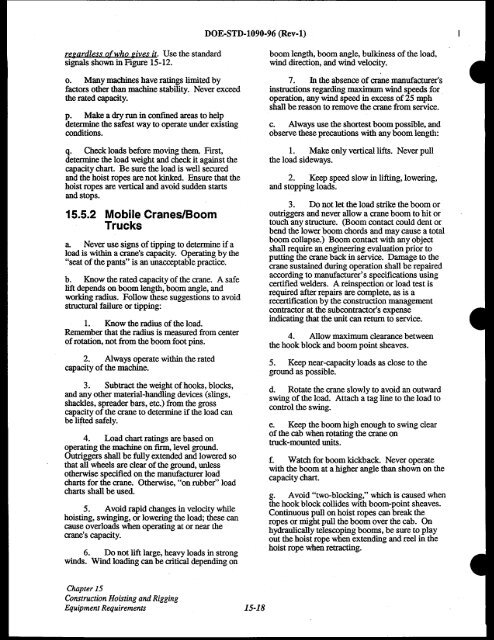DOE-STD-1090-96, DOE Standard Hoisting and Rigging Manual ...
DOE-STD-1090-96, DOE Standard Hoisting and Rigging Manual ...
DOE-STD-1090-96, DOE Standard Hoisting and Rigging Manual ...
Create successful ePaper yourself
Turn your PDF publications into a flip-book with our unique Google optimized e-Paper software.
<strong>DOE</strong>-<strong>STD</strong>-!090-<strong>96</strong> (Rev-!)regardless Q/wh Q gives it. Use the st<strong>and</strong>ardsignals shown in Figure 15-12.o. Many machines have ratings limited byfactors other than machine stability. Never exceedthe rated capacity.p. Make a dry run in conimed areas to helpdetermine the safest way to operate under existingconditions.q. Check loads before moving them. First,determine the load weight <strong>and</strong> check it against thecapacity chart. Be sure the load is well secured<strong>and</strong> the hoist ropes are not kinked. Ensure that thehoist ropes are vertical <strong>and</strong> avoid sudden starts<strong>and</strong> stops.15.5.2 Mobile CraneslBoomTrucksa. Never use signs oftipping to determine if aload is within a crane's capacity. Operating by the"seat ofthe pants" is an unacceptable practice.b. Know the rated capacity ofthe crane. A safelift depends on boom length, boom angle, <strong>and</strong>working radius. Follow these suggestions to avoidstructural failure or tipping:1. Know the radius ofthe load.Remember that the radius is measured from centerofrotation, not from the boom foot pins.2. Always operate within the ratedcapacity ofthe machine.3. Subtract the weight ofhooks, blocks,<strong>and</strong> any other material-h<strong>and</strong>ling devices (slings,shackles, spreader bars, etc.) from the grosscapacity ofthe crane to determine ifthe load canbe lifted safely.4. Load chart ratings are based onoperating the machine on firm, level ground.Outriggers shall be fully extended <strong>and</strong> lowered sothat all wheels are clear ofthe ground, unlessotherwise specified on the manufacturer loadcharts for the crane. Otherwise, "on rubber" loadcharts shall be used.5. Avoid rapid changes in velocity whilehoisting, swinging, or lowering the load; these cancause overloads when operating at or near thecrane's capacity.6. Do not lift large, heavy loads in strongwinds. Wind loading can be critical depending onboom length, boom angle, bulkiness ofthe load,wind direction, <strong>and</strong> wind velocity.7. In the absence ofcrane manufacturer'sinstructions regarding maximum wind speeds foroperation, any wind speed in excess of25 mp~shall bereason to remove the crane from SerVJ.ce.c. Always use the shortest boom possible, <strong>and</strong>observe these precautions with any boomlength:1. Make only vertical lifts. Never pullthe load sideways.2. Keep speed slow in lifting, lowering,<strong>and</strong> stopping loads.3. Do not let the load strike the boom oroutriggers <strong>and</strong> never allow a crane boom to hit ortouch any structure. (Boom contact could dent orbend the lower boom chords <strong>and</strong> may cause a totalboom collapse.) Boom contact with any objectshall require an engineering evaluation prior toputting the crane back in service. Damage to thecrane sustained during operation shall be repairedaccording to manufacturer's specifications usingcertified welders. A reinspection or load test isrequired after repairs are complete, as is arecertification by the construction managementcontractor at the subcontractor's expenseindicating that the unit can return to service.4. Allow maximum clearance betweenthe hook block <strong>and</strong> boompoint sheaves.5. Keep near-eapacity loads as close to theground as possible.d. Rotate the crane slowly to avoid an outwardswing ofthe load. Attach a tag line to the load tocontrol the swing.e. Keep the boom high enough to swing clearofthe cab when rotating the crane ontruck-mounted units.f. Watch for boom kickback. Never operatewith the boom at a higher angle than shown on thecapacity chart.g. Avoid "two-blocking," which is caused whenthe hookblock collides with boom-point sheaves.Continuous pull on hoist ropes can break theropes or might pull the boom over the cab. Onhydraulically telescoping boo~, be sure to. playout the hoist rope when extendmg <strong>and</strong> reel m thehoist rope when retracting.Chapter 15Construction <strong>Hoisting</strong> <strong>and</strong> <strong>Rigging</strong>Equipment Requirements 15-18
















